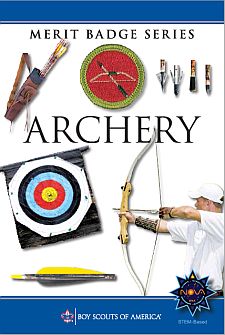- Do the following:
- State and explain the Range Safety Rules.
- Three safety rules when on the shooting line.
- Three safety rules when retrieving arrows.
- The four whistle commands used on a range and their related verbal commands.
- State and explain the general safety rules for archery. Demonstrate how to safely carry arrows in your hands.
- Tell about your local and state laws for owning and using archery tackle.
- State and explain the Range Safety Rules.
- Do the following:
- Name and point out the parts of an arrow.
- Describe three or more different types of arrows.
- Name the four principle materials for making arrow shafts.
- Make a complete arrow from a bare shaft.
- Explain how to properly care for and store arrows.
- Do the following:
- Explain how to proper care for and store tabs, arm guards, shooting gloves, and quivers.
- Explain the following terms: cast, draw weight, string height (fistmele), aiming, spine, mechanical release, freestyle, and barebow.
- Make a bowstring.
- Explain the following:
- The importance of obedience to a range officer or other person in charge of a range.
- The difference between an end and a round.
- The differences among field, target, and 3-D archery.
- How the five-color National Archery Association (NAA) or Federation Internationale de Tir a l'Arc (FITA) target is scored.
- How the National Field Archery Association (NFAA) black-and-white field targets and blue indoor targets are scored.
- The elimination system used in Olympic archery competition.
- Do ONE of the following options:
- Option A - Using a Recurve Bow or Longbow
- Name and Point to the parts of the recurve or longbow you are shooting.
- Explain how to properly care for and store recurve bows and longbows.
- Show the nine steps of good shooting for the recurve bow or longbow you are shooting.
- Demonstrate the proper way to string a recurve bow or longbow.
- Locate and mark with dental floss, crimp-on, or other method, the nocking point on the bowstring of the bow you are using.
- Do ONE of the following:
- Using a recurve or longbow and arrows with a finger
release, shoot a single round of ONE of the following BSA,
NAA,or NFAA rounds:
- An NFAA field round of 14 targets and make a score of 60 points.
- A BSA Scout field round of 14 targets and make a score of 80 points.
- A Junior 900 round and make a score of 180 points.
- A FITA/NAA indoor* round I and make a score of 80 points.
- An NFAA indoor* round and make a score of 50 points.
- Shooting 30 arrows in five-arrow ends at an 80-centimeter (32-inch) five-color target at 15 yards and using the 10 scoring regions, make a score of 150.
- As a member of the NAA's Junior Olympic Development Program (JOAD), qualify as a Yeoman, Junior Bowman, and Bowman.
- As a member of the NFAA's Junior Division, earn a Cub or Youth 100-score Progression patch.
- Using a recurve or longbow and arrows with a finger
release, shoot a single round of ONE of the following BSA,
NAA,or NFAA rounds:
- Option B - Using a Compound Bow
- Name and point to the parts of the compound bow you are shooting.
- Explain how to properly care for and store compound bows.
- Show the nine steps of good shooting for the compound bow you are shooting.
- Explain why it is necessary to have the string on a compound bow replaced at an archery shop.
- Locate and mark with dental floss, crimp-on, or other method, the nocking point on the bowstring of the bow you are using.
- Do ONE of the following:
- Using a compound bow and arrows with a finger release,
shoot a single round of ONE of the following BSA, NAA, or
NFAA rounds:
- An NFAA field round of 14 targets and make a score of 70 points.
- A BSA Scout field round of 14 targets and make a score of 90 points.
- A Junior 900 round and make a score of 200 points.
- A FITA/NAA indoor* round I and make a score of 90 points.
- An NFAA indoor* round and make a score of 60 points.
- Shooting 30 arrows in five-arrow ends at an 80-centimeter (32-inch) five-color target at 15 yards and using the 10 scoring regions, make a score of 170 160 .
- As a member of the NAA's Junior Olympic Development Program (JOAD), qualify as a Yeoman, Junior Bowman, and Bowman.
- As a member of the NFAA's Junior Division, earn a Cub or Youth 100-score Progression patch.
- Using a compound bow and arrows with a finger release,
shoot a single round of ONE of the following BSA, NAA, or
NFAA rounds:
- Option A - Using a Recurve Bow or Longbow
* The indoor rounds may be shot outdoors if this is more convenient.
BSA Advancement ID#:
19
Requirements last updated in:
2012
Pamphlet Publication Number:
35856
Pamphlet Stock (SKU) Number:
35856
Pamphlet Revision Date:
2004
| Worksheets for use in working on these requirements: | Format | |
|---|---|---|
| Word Format | PDF Format | |
Page updated on: November 18, 2021









